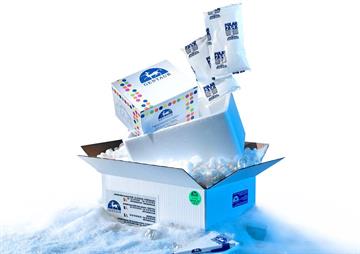Anti-Human BD-1 Antibody

Anti-Human BD-1 Antibody
518.55 EUR
In Stock
quantity
Produktdetaljer
Katalognummer: 209 - 102-P219
Produktkategori: Företag och industri > Vetenskap och laboratorium
ReliaTechGentaur
Storlek: 100 µg
Related Products
102-P219
Anti-Human BD-1 Antibody
Defensins (alpha and beta) are cationic peptides with a broad spectrum of antimicrobial activity that comprise an important arm of the innate immune system. The α-defensins are distinguished from the β-defensins by the pairing of their three disulfide bonds. To date, six human β-defensins have been identified; BD-1, BD-2, BD-3, BD-4, BD-5 and BD-6. β-defensins are expressed on some leukocytes and at epithelial surfaces. In addition to their direct antimicrobial activities, they can act as chemoattractants towards immature dendritic cells and memory T cells. The β-defensin proteins are expressed as the C-terminal portion of precursors and are released by proteolytic cleavage of a signal sequence and in some cases, a propeptide sequence. β-defensins contain a six-cysteine motif that forms three intra-molecular disulfide bonds.
518.55 €
102-P103G
Anti-Human BD-2 Antibody
Defensins (alpha and beta) are cationic peptides with a broad spectrum of antimicrobial activity that comprise an important arm of the innate immune system. The α-defensins are distinguished from the β-defensins by the pairing of their three disulfide bonds. To date, six human β-defensins have been identified; BD-1, BD-2, BD-3, BD-4, BD-5 and BD-6. β-defensins are expressed on some leukocytes and at epithelial surfaces. In addition to their direct antimicrobial activities, they can act as chemoattractants towards immature dendritic cells and memory T cells. The β-defensin proteins are expressed as the C-terminal portion of precursors and are released by proteolytic cleavage of a signal sequence and in some cases, a propeptide sequence. β-defensins contain a six-cysteine motif that forms three intra-molecular disulfide bonds.
518.55 €
102-P220
Anti-Human BD-3 Antibody
Defensins (alpha and beta) are cationic peptides with a broad spectrum of antimicrobial activity that comprise an important arm of the innate immune system. The α-defensins are distinguished from the β-defensins by the pairing of their three disulfide bonds. To date, six human β-defensins have been identified; BD-1, BD-2, BD-3, BD-4, BD-5 and BD-6. β-defensins are expressed on some leukocytes and at epithelial surfaces. In addition to their direct antimicrobial activities, they can act as chemoattractants towards immature dendritic cells and memory T cells. The β-defensin proteins are expressed as the C-terminal portion of precursors and are released by proteolytic cleavage of a signal sequence and in some cases, a propeptide sequence. β-defensins contain a six-cysteine motif that forms three intra-molecular disulfide bonds.
518.55 €
102-P256
Anti-Human Wnt-1 Antibody
Proto-oncogene protein Wnt-1 is a protein that in humans is encoded by the WNT1 gene. The WNT gene family consists of structurally related genes that encode secreted signaling proteins. These proteins have been implicated in oncogenesis and in several developmental processes, including regulation of cell fate and patterning during embryogenesis.
518.55 €
102-P28
Anti-Human IGF-1 Antibody
Insulin-like growth factor (IGF)-I (also known as somatomedin C and somatomedin A) and IGF-II (multiplication stimulating activity or MSA) belong to the family of insulin-like growth factors that are structurally homologous to proinsulin. Mature IGF-I and IGF-II share approximately 70% sequence identity. Both IGF-I and IGF-II are expressed in many tissues and cell types and may have autocrine, paracrine and endocrine functions. Mature IGF-I and IGF-II are highly conserved between the human, bovine and porcine proteins (100% identity), and exhibit cross-species activity.
518.55 €
102-PA138
Anti-Human Mdg-1 Antibody
Angiogenesis research has focused on receptors and ligands mediating endothelial cell proliferation and migration. Little is known about the molecular mechanisms that are involved in converting endothelial cells from a proliferative to a differentiated state. Microvascular differentiation gene 1 (Mdg1) has been isolated from differentiating microvascular endothelial cells that had been cultured in collagen type I gels (3D culture). In adult human tissue Mdg1 is expressed in endothelial and epithelial cells. Sequence analysis of the full-length cDNA revealed that the N-terminal region of the putative Mdg1-protein exhibits a high sequence similarity to the J-domain of Hsp40 chaperones. It was shown that this region functions as a bona fide J-domain as it can replace the J-domain of Escherichia coli DnaJ-protein. Mdg1 is also upregulated in primary endothelial and mesangial cells when subjected to various stress stimuli. GFP–Mdg1 fusion constructs showed the Mdg1-protein to be localized within the cytoplasm under control conditions. Stress induces the translocation of Mdg1 into the nucleus, where it accumulates in nucleoli. Costaining with Hdj1, Hdj2, Hsp70, and Hsc70 revealed that Mdg1 colocalizes with Hsp70 and Hdj1 in control and stressed HeLa cells. These data suggest that Mdg1 is involved in the control of cell cycle arrest taking place during terminal cell differentiation and under stress conditions.
457.12 €
Håll dig uppdaterad! Visa tidigare publikationer

By: Author , 2 Comment
Anaplasmos hos hundar och katter – allt du behöver veta
23 August 2025

By: Author , 2 Comment
Solbränna – hur leker man säkert i solen?
16 August 2025

By: Author , 2 Comment
Biologiska läkemedel – Modernitet inom farmaci
1 August 2025

By: Author , 2 Comment
Icke-steroida antiinflammatoriska läkemedel – viktig information om populära läkemedel
22 July 2025








